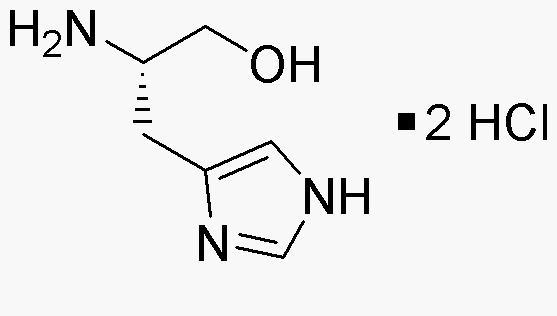L-Histidinol dihydrochloride is widely utilized in research focused on:
- Biochemical Research: It serves as a precursor in the biosynthesis of histidine, aiding researchers in studying amino acid metabolism and protein synthesis.
- Pharmaceutical Development: This compound is explored for its potential in developing new drugs, particularly those targeting metabolic disorders related to amino acid deficiencies.
- Enzyme Studies: It is used in enzyme activity assays, helping scientists understand the mechanisms of enzymes that utilize histidine in their active sites.
- Cell Culture Applications: L-Histidinol dihydrochloride can be added to cell culture media to promote growth and support the development of specific cell lines, particularly in genetic studies.
- Nutrition Research: It is investigated for its role in dietary supplements, especially for populations at risk of amino acid deficiencies, providing insights into nutritional interventions.
General Information
Properties
Safety and Regulations
Applications
L-Histidinol dihydrochloride is widely utilized in research focused on:
- Biochemical Research: It serves as a precursor in the biosynthesis of histidine, aiding researchers in studying amino acid metabolism and protein synthesis.
- Pharmaceutical Development: This compound is explored for its potential in developing new drugs, particularly those targeting metabolic disorders related to amino acid deficiencies.
- Enzyme Studies: It is used in enzyme activity assays, helping scientists understand the mechanisms of enzymes that utilize histidine in their active sites.
- Cell Culture Applications: L-Histidinol dihydrochloride can be added to cell culture media to promote growth and support the development of specific cell lines, particularly in genetic studies.
- Nutrition Research: It is investigated for its role in dietary supplements, especially for populations at risk of amino acid deficiencies, providing insights into nutritional interventions.
Documents
Safety Data Sheets (SDS)
The SDS provides comprehensive safety information on handling, storage, and disposal of the product.
Product Specification (PS)
The PS provides a comprehensive breakdown of the product’s properties, including chemical composition, physical state, purity, and storage requirements. It also details acceptable quality ranges and the product's intended applications.
Certificates of Analysis (COA)
Search for Certificates of Analysis (COA) by entering the products Lot Number. Lot and Batch Numbers can be found on a product’s label following the words ‘Lot’ or ‘Batch’.
*Catalog Number
*Lot Number
Certificates Of Origin (COO)
This COO confirms the country where the product was manufactured, and also details the materials and components used in it and whether it is derived from natural, synthetic, or other specific sources. This certificate may be required for customs, trade, and regulatory compliance.
*Catalog Number
*Lot Number
Safety Data Sheets (SDS)
The SDS provides comprehensive safety information on handling, storage, and disposal of the product.
DownloadProduct Specification (PS)
The PS provides a comprehensive breakdown of the product’s properties, including chemical composition, physical state, purity, and storage requirements. It also details acceptable quality ranges and the product's intended applications.
DownloadCertificates of Analysis (COA)
Search for Certificates of Analysis (COA) by entering the products Lot Number. Lot and Batch Numbers can be found on a product’s label following the words ‘Lot’ or ‘Batch’.
*Catalog Number
*Lot Number
Certificates Of Origin (COO)
This COO confirms the country where the product was manufactured, and also details the materials and components used in it and whether it is derived from natural, synthetic, or other specific sources. This certificate may be required for customs, trade, and regulatory compliance.


